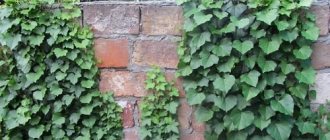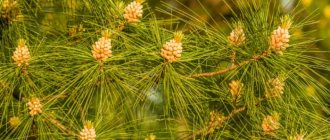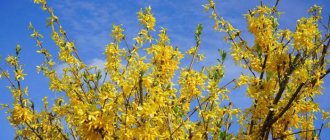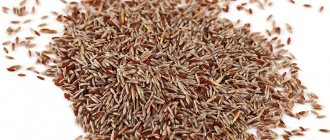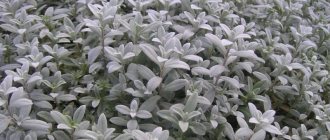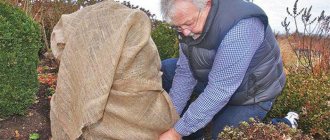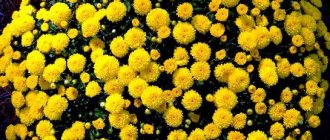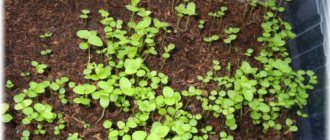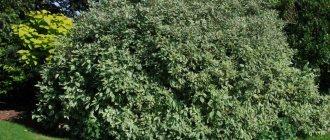Garden ivy - specifics, care process, types of reproduction
It has several origins of the name - evergreen garden ivy (Hedera helix) - a climbing vine-like perennial, an evergreen plant of the Araliaceae family. The name in Latin comes from the Greek word “oedon” - singer. There is another variation of the origin of the name from the Celtic “hedea” - cord. The specific name comes from “helisso” - to curl. The plant is famous in South-West Asia, South, Western and Central Europe. Geographically in the Russian Federation, garden ivy grows in the Caucasus - Krasnodar Territory, Crimea. The natural habitat for ivy is considered to be beech and oak woodlands, lowlands and foothills.
General information
Garden ivy mainly grows in warm regions, but there are also frost-resistant species. Many varieties have leathery, shiny leaves with a smooth surface and numerous veins. Varieties are distinguished by the structural features of the leaves - three-fingered, five-fingered, heart-shaped.
The color of the leaf blades is mostly monochromatic – greenish. It is possible to encounter varieties of multi-colored sheets: with yellow specks, reddish stripes and a whitish border at the edges. The plant has the ability to spread over different surfaces with the help of a large number of suckers - roots clinging to completely different surfaces.
The size of ivy sprouts varies up to 3 meters. At the moment of color, small green-yellowish flowers appear on the plant, formed into umbrellas, which have no decorative value. Flowers attract all kinds of insects, such as bees. When the pollination period is over, small berries are formed that are close in color to black.
Important: ivy is a toxic plant. The toxic contents are distributed throughout the substrate. If it comes into contact with the skin, it causes irritation, redness and sometimes burns. But not all people are sensitive to the toxic substances in ivy. It is recommended to work with gloves.
Caring for ivy in the garden
Garden ivy is native to Northern Europe. And therefore this plant is quite hardy. However, the climate in Russia, unfortunately, is still more severe than in Europe. Therefore, in our country, ivy can be grown outdoors mainly only in the southern regions. Only some varieties of common ivy are suitable for the middle zone. Moreover, in this case they can be used mainly only as ground cover.
The place for this plant in the garden is chosen depending on the color of the leaves. For dark green ivy, partial shade is also quite suitable. Forms with variegated leaves need bright lighting. This decorative plant is watered in the garden using approximately the same technology as in indoor conditions. The ivy leaf of almost any variety is actually very beautiful and represents the main decorative value of this plant. Therefore, it is better to water the vines in the mornings or evenings using the sprinkling method. This way, it will be possible not only to moisten the soil under the ivy, but also to wash off the dust from its lashes.
You can feed this ornamental crop with ordinary rotted manure. This plant also responds very well to ash. Ivy of any variety, of course, is primarily an ornamental plant. This liana is hardy and unpretentious. But sometimes it happens that the ivy lashes slow down and its leaves turn pale. In this case, the plants should be fed with urea (a matchbox per 10 liter bucket of water).
Varieties
Common ivy (Hedera helix)
...very common in the Russian Federation, as it is frost-resistant. It has a slow growth rate and can grow in the garden and indoors. Prefers a place protected from drafts and easy to care for.
Twisty vines grow up to 1 meter, with alternately arranged glossy leaves. Any leaf blade upon detailed examination demonstrates division into 3 lobes, a surface with colorful veins.
The moment of flowering occurs in the autumn months. They knock out racemose arrows dotted with flowers up to half a centimeter in size and up to 2.5 millimeters wide.
Colchis ivy (Hedera colchica)
Under natural conditions, you will be lucky enough to meet it in the North of the planet, in Australia and the Caucasus. It is characterized by rapid growth, the size of the processes increases to thirty meters. The dark green matte leaf plates are larger than those of their counterparts: they can grow up to seventeen centimeters in width, up to twenty centimeters in length, and are planted on cuttings ranging from one to three centimeters in size. If the leaf is rubbed, a special musky aroma will appear.
Branches of both sexes grow on one bush. The color season is the autumn months. The flowers are racemose yellow and white. The fruits are black, collected in clusters, and have three to five seeds inside.
Colchis ivy
Shows aggression towards other plants. Initially, it provides nutrition to plants used as support. After three to four years, it destroys its neighbors with the help of vines, and as a result, the plants are inevitably destroyed. The same fate awaits the building - the most powerful adventitious roots destroy the concrete. This type of plant is found as an indoor or office flower.
Caucasian ivy (Hedera caucasicum)
Frost-resistant species, can withstand temperatures of minus twenty degrees Celsius. Arrow-shaped leaf blades of light green or variegated colors. Considered a late honey plant, it blooms in November. Bees pollinate fragrant flowers with a musky aroma. Caucasian ivy honey has great value on the market and is similar in taste to white acacia honey product.
At the end of flowering, berries are formed on the vines, suitable for bird food. Caucasian ivy vines easily take root in the ground and do not require support. They occupy large areas and become a ground cover plant. This type is used exclusively for decorating gazebos and organizing green screens. It is less often preferred as a plant that decorates the walls of buildings, since ivy retains moisture, as a result the house will be damp and mold may develop.
Garden ivy: how to plant, care and propagate
Ivies are unpretentious and pliable. The plant can be grown as a ground cover, as a lush carpet on the ground, and as a climber. Heders are easy to care for - after planting, it is enough to water, sometimes weed, and mulch the plant in the fall. You can propagate ivy at home on your site by seeds, shoots, cuttings and layering. The shoots of the plant themselves are fixed to the supports with the help of aerial roots, without requiring additional support.
The plant is an evergreen perennial vine with green or variegated lobed leaves - dense, with heart-shaped bases. In cultivation, common ivy is usually used as an ornamental plant, less often Colchian ivy.
Hederas bloom at the age of 10-12 years with small, inconspicuous, unpleasant-smelling flowers. Their berries are poisonous to humans. Lianas bloom in late autumn. The plant can have unisexual and bisexual flowers. Male and bisexual stamens have 5 stamens, while females have a pistil. The ivy fruit is the size of a pea. Inside there are 3-4 wrinkled, light-colored seeds.
Hedera is not a parasitic plant. It does not harm the trees it braids. Ivy is attached to the support by aerial roots. Without the need for nets and trellises, it is able to climb rough stone walls on its own, so it is advisable to use it when landscaping unplastered stone walls.
Types of garden ivy:
View
Description
Varieties
Common ivy (Hedera Helix)
A powerful evergreen shrub with vines up to 25 m long, covered with leathery glossy leaves with a golden marbled tint. A fast-growing vine that can create a real curtain of foliage. Many varieties have been developed, varying in shape, size and color of leaves.
Persian ivy (Hedera colchica)
Large-leaved, ideal for covering walls. To ensure that the curtain made from this plant always looks attractive, it will have to be trimmed regularly.
Dentata variegata – leaves 15 cm in diameter, light green, speckled, with cream edges
Iberian ivy (Hedera Iberica)
Leaves in the shape of a clearly cut heart with beautiful veins
Deltoidea - suitable for vertical gardening and growing in pots. Grows wider than tall
Caucasian ivy (Hedera Caucasicum)
Frost-resistant, withstands frosts down to -20. Late honey plant, blooms in November, when there are very few flowering plants
Grow indoors:
- Indoor ivy - well suited for dark, cold and dry rooms. The plant has leathery, durable, smooth leaves, uniform, dark green, with a lot of chlorophyll. Such plates can be satisfied with even a small amount of light.
- Wax ivy - suitable for insufficiently lit and humid rooms with a temperature of 20-25 degrees. This species has thinner and more delicate leaf blades of different shades of green.
Ivy grows in almost any soil, in the sun and in dense shade. The plant is viable, surviving even in places poorly adapted for it. Hedera has many variegated forms. They are all very light-loving. In the shade, variegated ivy will not die, but will turn into ordinary, green ones.
Ivy is a moderately heat-loving plant. It grows best at a temperature of 14-17 degrees. In winter, plants are kept at a temperature of 10-15 degrees, but they will not die at higher temperatures. In the southern regions, heders winter well under the crowns of large trees.
Ground cover specimens overwinter better than those grown in a vertical culture.
Ivy loves frequent spraying and is very responsive to feeding. In summer it is watered abundantly, in winter - occasionally, but the earthen lump should not dry out. In the hot season, plants are fertilized every 10 days with a mineral composition containing nitrogen, phosphorus and potassium, diluting 10-15 g of fertilizers in 10 liters of water. In winter, fertilizing is not carried out. The lower the air temperature, the less often you need to water and spray. If the leaves turn yellow and fall off, it means the plant does not have enough moisture.
Mulch is useful both in the fall (as a winter shelter) and during the growing season, in the warm season. Porous organic matter protects the soil from drying out and, in rainy years, from rotting. The mulch is poured in several stages, each time spreading it over the surface of the earth in a thin layer, trying not to touch the low-lying leaves. After several additions, by winter, mulch will be able to protect the roots from frost.
In the spring, when the snow melts, there is no need to rush to cut off frozen shoots. It is better to postpone the procedure until the summer, when active sap flow stops. Extensive cuts are covered with varnish.
Hedera blooms if it can get out of the shadows into the light. The berries hang on the plant all winter and ripen only next spring.
When the ivy grows too much, its branches can be trimmed. The leaves stay on the vines for a long time. The shoots are laid on the ground and covered with earth or pressed down with garden pins, after which they will take root and new branches will grow from them. In order for the ivy to branch better and not lose its decorative appearance, its shoots are pinched by hand several times a year, and heavily exposed vines are shortened by pruning.
Article rating:
Evergreen ivyLink to main publication
Related publications
- Goldenrod
- Perennial pink cornflower
- Small yellow flowers
- What is anemone
- Lavatera flowers
- What types of wildflowers are there?
- Sedum prominent diamond
- Lotus color
- Meadowsweet when it blooms
- When to sow perennial poppy
- Scabiosa planting and care
- Euphorbia vine
Specifics of care
Garden ivy is an undemanding plant, grows everywhere, it just doesn’t like clay. A suitable mixture for dilution is soil with lime and humus - a moisture-containing and breathable substance. For plants with dark green leaf color, a shady place is preferable. A support for the vine is needed near the landing site. Plant growth initially after planting is slow. Therefore, it is important to plant ivy in open ground in the spring to strengthen the rhizome.
If the air is dry, the leaf blades may dry out and die. To eliminate this phenomenon, it is recommended to frequently spray water from a spray bottle. In summer, moisturizing is necessary constantly - a couple of times every seven days, the top layer should be damp. In the winter season, moisture is reduced. Do not forget to loosen the soil - the circulation of oxygen flow will not be complicated.
It is recommended to feed with nitrogen supplements in summer; in winter, an increase in potassium and phosphorus is required. You can also use manure diluted with water. Garden ivy is pruned in the autumn, getting rid of shoots and dry leaves. To make the plant plump, each shoot is pruned. The incision sites require treatment with garden varnish - it has a healing function.
Planting, care and propagation of garden ivy
For residents of the middle zone, hedera, an unpretentious evergreen ivy, is more familiar as a popular hanging plant for the home.
But in the southern regions of the country it is garden ivy. Huge thickets of this culture can be found in the Crimea and the Caucasus. As the ivy grows, it climbs inaccessible slopes and the walls of houses, covers the slopes with a dense carpet, and its shoots hang from the trees. Plants belonging to perennial evergreen vines are not capricious, not demanding in terms of growing conditions and care. They grow quickly and readily delight with decorative foliage of various shapes and colors.
It is not surprising that the plant has been noticed by gardeners for a very long time. In Europe, evergreen garden ivy, which remains attractive throughout the year, is used to decorate hedges, landscaping urban and rural buildings, parks and gazebos.
toNature.info
Ivy is often used as an ornamental plant for a variety of landscape solutions. For example, you can perfectly decorate a fence or one of the walls of a house with ivy, colorfully plant ivy on the balcony, or even make certain designs and compositions using this wonderful plant.
In addition, ivy even blooms like a climbing evergreen. The flowering period occurs from September to October. Another plus to the list of plant priorities is the fact that ivy is an almost unpretentious plant that quickly develops and recovers if you give it proper attention and care. In this case, this is good, because, unlike other plants, whose growth depends on natural conditions and the environment, ivy feels fine both in well-lit areas, for example, and in fairly dark areas. And thank God! After all, it would be a big hassle for us to shade it further, or, conversely, to highlight it when some direction was missing.
Ivy grows quite quickly and well if you follow the conditions of care, choose the right soil and protect it from parasites. If any aspect of plant care has suffered, then the ivy needs to be given proper treatment. But, returning again to the point that the plant grows quickly, it will not be difficult to develop and restore ivy, because its growth will play into your favor. If any parts of the plant are damaged, you need to carry out a pruning procedure. Pruning always renews any plant and is recommended to be used in cases where the plant begins to become dull in growth and lose its vitality, produce scanty shoots or stops blooming altogether.
In the case of ivy, shoots that are already quite dried out need to be completely cut off, but those that can still be saved need to be cut back to the desired point. This means that pruning is carried out a couple of centimeters below the damaged area. Then, you will have to work very hard to care for the plant: water correctly and systematically, according to a schedule, and also take care of the soil, periodically applying fertilizers during the feeding season. Fertilizers are generally a powerful thing if you want to see tremendous growth and development of ivy, or indeed any other plant. If the fertilizers are chosen correctly, you will see that your ivy always blooms, crawls well, develops and grows well.
To summarize, let’s say that the Common Ivy plant grows and develops well if there are all the conditions for this, but if you still didn’t guess with some nuances, it doesn’t matter. Ivy can grow in both well-lit and dark places. The main thing is to water very well and constantly ensure that there are no pests, and then your ivy will delight you constantly. Don't forget that ivy is great for decorating house facades and fences, so opt for this representative of evergreen plants.
Please rate the material you read :)
( 7 rated, score: 4.14 out of 10)
Description of garden ivy and cultivated species
In nature, there are one and a half dozen species of ivy.
All of them are perennial climbing shrubs with long shoots that cling to soil, stones, other vegetation and walls with the help of numerous adventitious roots formed on the adult part of the stem. Depending on the type of garden ivy, the leaves can be either cut, three- or five-fingered, or whole. The leaf blades of most garden ivy are dense, leathery with a smooth surface and radiating veins. In addition to plants with monochromatic, green foliage, variegated specimens can be seen even in the wild.
While the long shoots and decorative foliage of garden ivy, reaching 30 meters in length, immediately catch the eye, the flowering of representatives of this genus sometimes goes unnoticed. The greenish flowers collected in capitate or umbellate inflorescences are very small and have no decorative value.
The small round fruits of a dark, almost black color that form after pollination look much more interesting.
Only a few of the most cold-resistant species are grown in cultivation in Russia:
- Common garden ivy is the most common plant and is also used as a houseplant. This species is distinguished by a slow growth rate, relatively medium-sized three- or five-fingered leaf blades and an abundance of varieties.
- Colchian or Caucasian ivy also grows in gardens. A strong, fast-growing vine with shoots up to 30 meters long and leaves sometimes reaching 20 cm in diameter, it is found in nature in the foothills of the Caucasus, as well as in a number of Asian regions. The shape of green or variegated leaves changes as they grow.
- Crimean ivy is another Russian species that looks similar to the Maltese variety grown in Europe. Heat-loving plants, when exposed to favorable conditions, become powerful. Their trunks become woody at the base, sometimes merging with the trees that this garden ivy readily climbs.
Description of varieties and varieties of evergreen ivy
Biologists know many varieties of this perennial plant that carpets mountains and plains. Ivy has a large number of long roots, with which it clings to everything that gets in its way. Its leaves are a rich dark green color, and there are variegated varieties. You can determine which ivy is best to get for your site by looking at the photo.
Gardeners plant evergreen ivy on their plots, near houses and gazebos. The following cold-resistant plant varieties are more common.
- Common ivy - planting is possible at home and in natural conditions. It grows slowly. The leaf plates are medium-sized, openwork. In open ground it is often planted to decorate paths, artificial ponds, and clearings.
- Colchis (Caucasian) ivy is planted in gardens, near buildings. It clings, grows upward and beautifully covers all the walls and supports. As they grow, the leaves become large and change their shape and color. Can grow up to 30 m long. Maintenance is not troublesome.
Planting and caring for garden ivy
Ivy is rightfully considered a shade-tolerant crop that easily adapts to life as a ground cover plant.
Settled under the crowns of large trees in the southern regions, it winters well. But the further north you go, the higher the risk of freezing, not only due to low temperatures, but also due to high humidity and insufficient shelter. To protect the plant and make it easier to care for garden ivy, planting is done in elevated places protected from the wind. The first few years the crop does not grow too quickly, so young ivy is planted in the spring so that the seedlings ripen during the warm season and overwinter better. To propagate ivy, choose healthy shoots no older than 2–3 years. In this case, they will take root well and will not have to be seriously injured when transferred to a new place.
Ivy plants suitable for the garden are not too fussy and adapt well. To make this happen faster, a moisture-intensive, breathable substrate with a high organic content is prepared for planting. The main part of the ivy roots is located at a depth of up to 20 cm, so the planting hole is prepared a little deeper. A drainage layer must be provided at the bottom.
After planting garden ivy, care consists of watering, fertilizing and simple soil cultivation. Very careful loosening will help to increase the permeability of the soil to air and moisture, and mulching will help conserve moisture and protect plants from the first frosts by winter.
The soil is loosened to avoid the formation of a dense crust after rain, trying not to harm the shoots and their adventitious roots, which form closer to the nodes and quickly penetrate the substrate as they grow.
Mulching with leaf humus, peat, or other porous organic matter prevents the soil from drying out and, in wet years, from rotting. The mulch is added gradually, in a thin layer in several stages, so as not to affect the foliage located near the ground. By autumn, the layer is increased in order to carry out full-scale insulation and shelter of plants with the arrival of cold weather.
The further north you go, the more likely it is that plants used for vertical gardening will freeze. This fully applies to ivy for hedges, decoration of arches and walls of houses. Ground cover specimens, especially those additionally covered with snow, winter better.
After the snow melts in the spring, you should not rush to trim shoots damaged by frost or for other reasons.
It is better to remove them at the beginning of summer, when the active movement of juices has ended. Cuts on large stems are treated with garden varnish. Garden ivy should be watered regularly throughout the season, but in moderation, keeping an eye on the soil moisture under the plants.
Features of care
Further care for ivy will not cause difficulties.
- If the plant is young, it should be directed towards a fence, wall or other support along the twine. Then it will cling to vertical surfaces on its own.
- It is necessary to water moderately, avoiding stagnation of moisture, which can cause rotting of the root system.
- You can feed once a month with mineral or organic fertilizers. During the active growing season, use nitrogen fertilizers; at the end of summer and beginning of autumn, use potassium-phosphate fertilizers.
- The soil should be periodically loosened, and its surface should be mulched around the plant. Leaf humus, peat or wood chips are suitable for these purposes.
The young plant must be covered for the winter. You can carefully remove the ivy from the support, place it on the ground, cover it with dry leaves and cover it with a box. Snow cover will enhance protection against freezing. In spring, the plant is lifted and tied up again. As soon as the ivy rises above 1.5 m, gains strength and mass, it can not be removed.
Periodically, ivy should be trimmed, removing excess and forming a crown. Cuttings can be rooted, thereby propagating the plant.
Propagation of evergreen ivy
Most species suitable for growing in the garden form adventitious or aerial roots. This makes it quite easy to root cuttings taken in the spring and summer months.
Semi-lignified shoots with visible rudiments or already real adventitious roots are suitable for ivy propagation. If you cut off very young, green growth, the rooting process takes much longer. And under unfavorable conditions, for example in cool weather, the cuttings may even rot.
To propagate evergreen ivy, it is better to use apical cuttings, but if this is not possible or you need to get a lot of young plants, the shoot is cut into 10 cm fragments, with at least one healthy node.
You can root the cuttings in an outdoor greenhouse, planting several of them in loose, light soil, or in plain water. When a sufficient number of roots appear on the stems, the plants are transferred to their future location. Taking into account the growth of ground cover shrubs and the peculiarities of caring for garden ivy, planting is carried out at a distance of at least half a meter from each other.
Decorating the walls of the house with ivy - video
Description and photo
The ivy fence looks like the pearl of the site! The main species in central Russia can be considered common ivy, which grows well in the Moscow region and blooms in August. Its length can be up to 30 meters. The liana is also used as a ground cover plant.
The flowers are small and collected in racemes. They are not particularly beautiful. At the same time, ivy is an excellent honey plant. It has light honey, almost white, with a characteristic mint smell.
Common ivy berries are poisonous to humans! Birds consume its fruits with pleasure and without harm to their lives.
Botanical description
Common ivy is an evergreen climbing shrub that is capable of attaching its sucker-shaped adventitious roots to various objects (trees, house walls, hedges, etc.), using them as a support. It can reach 20-30 m in height and also grow as a ground cover plant. Considered a weed in many regions, it grows in a wide range of soil pH, but an acidity of 6.5 is ideal for it. Prefers moist, shaded places and avoids exposure to direct sunlight.
The leaves are alternate, leathery, smooth, 50-100 mm in length, petiole 10-20 mm.
Ivy has two types of leaves:
- adults are fan-shaped, with five lobes;
- young ones - with three lobes on creeping stems and heart-shaped on fruiting, flowering shoots that are open to the sun and usually crown the crown.
The flowers are small, greenish-yellow, have no decorative value, and appear from late summer to autumn. They are a good source of nectar for bees. The fruits are purple-black, ripen in winter and are included in the diet of many birds, but are poisonous to humans.
Where is the best place to plant
Before planting ivy, you should think about and plan its location, as it has an amazing ability to spread throughout the entire area. The whole beauty of this plant is in the leaves, which are hard and shiny. Ivy seedlings love elevated locations, but do not tolerate drafts and strong winds.
Like most plants, ivy is planted in the spring, as early as possible. To plant a seedling, you need to dig a hole slightly larger than the root and put small pebbles or crushed stone on the bottom.
Ivy loves moist soil and partial shade. It is desirable that the soil contains lime and humus. Seedlings are placed at a distance of 50 cm, no closer. The maximum distance can be about 1 meter.
Neighborhood with other cultures
The liana makes good friends with neighboring plants. Pairs perfectly with conifers, flowering shrubs and roses. In vertical gardening, ivy harmonizes well with morning glory.
How to grow indoors: preparing the pot
Ivy is a plant that has long vines, but at the same time a not very well developed root system. Therefore, there is no need to use a very large pot for this decorative crop indoors. A medium-sized container is quite suitable for ivy. In order for the plant to develop well, its pot should be filled with a soil mixture of the following composition:
- humus;
- sand;
- leaf soil;
- turf soil.
All these components must be taken in equal quantities and mixed thoroughly. Evergreen garden ivy, like most other indoor plants, does not like stagnant water. Therefore, you should definitely put broken shards or expanded clay at the bottom of the pot.
Reproduction methods in the Moscow region
Of course, ivy can initially be grown from seeds, but this will take more time.
The plant is propagated mainly by cuttings. Cuttings can be taken from any part of the vine. Although it is still preferable to use apical shoots that have not yet become completely woody and have noticeable adventitious roots. The length of the cuttings should be approximately 10 cm. They are placed in a container with water or in a loose and moist substrate (a mixture of soil and sand).
After the roots have appeared on the cutting, and they appear within a few days, it can be safely planted in a permanent habitat. This technique makes it possible not only to quickly grow the required number of plants for mass gardening, but also to significantly save your budget.
An alternative way to propagate ivy is by cutting. It is as easy to use as the previous one. You need to put the shoot, which has 8 leaves or a little more, on the ground, lightly press it and sprinkle it with soil. The leaves should remain on the surface. This action deepens the aerial roots. In this case, the vine is watered regularly and after 10 days the aerial roots will become underground. This will form an independent plant.
Methods for growing and propagating garden and indoor ivy
Hedera garden ivy is a climbing vine. It is an unpretentious perennial plant. Belongs to a fast-growing subspecies.
Endowed with leaves of different shapes and sizes. The color of the leaves is different. They can be plain, with strokes, borders and dots.
The branches reach 2.5-3.0 meters in length. The inflorescences are umbellate. The pleasant aroma attracts numerous insects.
Therefore, when growing at home, it is necessary to install a protective mesh screen on the windows. After flowering, inedible berries appear.
How to grow ivy from seeds?
Let's consider whether it is possible to grow ivy at home.
After flowering, the plant retains small berries. The color of the berries depends on the subspecies of the plant. There are seeds inside them. They are taken out and dried for 1-2 days . The seeds can also be placed in a growth stimulator. This procedure will increase shelf life and germination.
Bowls must be used as containers. The prepared substrate is poured into them. Place the seeds one at a time at a distance of 5-10 cm from each other . The planting is watered with water from a sprayer. It is necessary to build a mini-greenhouse on top.
Use glass jars, cut plastic bottles or transparent cellophane. Also, if the container is too wide, the bowl can be covered with plain glass.
This design maintains the greenhouse effect and stable temperature. Without a greenhouse, the seeds will not sprout . In the evening hours, future seedlings are artificially illuminated.
Since the glass cannot be opened, the seeds are watered from a tray. Water is poured onto it until it evaporates completely. It is important that drainage holes are made in the bowl. Otherwise, moisture will not enter the container.
The soil must be kept moist at all times. After 14-30 days, the first shoots should appear . After 2-3 leaves appear on the sprouts, they are transplanted into separate pots for permanent growth.
Reproduction
Let's look at how to propagate indoor ivy.
Apical stalks
This type of propagation is carried out after pruning the plant . The tips of the stems are cut off from the perennial. The length of the planting material should be at least 8-12 cm.
Seedlings are rooted in water. It is necessary that the water be soft , without any chemical impurities. The cuttings are placed in water so that the leaves are on the surface and do not reach the water. Water is added periodically. When the first roots appear, the plant is transplanted into the ground.
Another method of rooting is planting in a moist substrate . To do this, you will need a container, bowl or shallow container made of metal or wood.
It is not recommended to use pots made of plastic or wood shavings. When watered, such material releases toxins.
The container is filled with purchased or prepared substrate. Cuttings are planted one by one.
It is necessary that there is a space of 40-55 cm . You can build a homemade greenhouse on top. It is made from glass jars, cut plastic bottles or cellophane.
It is important that the material is translucent. Such greenhouses create a greenhouse effect. Thanks to stable temperatures, cuttings take root much faster. If the plant is artificially illuminated in the evening hours, then the first roots appear in 7-21 days . After the flower begins to grow and the first leaves appear, it is transplanted into separate containers for permanent growth.
Another way to propagate Heder's ivy is through shoots. The whole stem of the plant is used as planting material . It is necessary that it has at least 8-12 developed leaves. This method of propagation is easier than propagation by small stems.
The more leaves there are on the cutting, the faster rooting will occur. A longitudinal cut is made on the stem with garden shears or a sharp knife. Since ivy is a hanging, creeping plant, rooting can be done horizontally . To do this you will need a wide bowl.
The stem is laid with the cut down. The depth of indentation should be no more than 2.0-2.5 cm.
Otherwise, the roots will take a very long time to strengthen. And with poor care, they can weaken and not germinate. When pressed, the leaves should appear on the surface of the soil. Otherwise they will rot in the ground.
When growing, the substrate should always be kept moist. If you allow the soil to dry out for a long time, the plant will not take root. The root system should appear along the entire length of the cut stem.
Rooting occurs in 10-21 days . After complete rooting occurs, the plant will begin to grow.
After this, the planting material is pulled out from the substrate. The stem is cut into small pieces with a root system. It is important that there are 2-3 leaves left on each segment. Seedlings are planted in ready-made containers for permanent growth. With proper care, new leaves should appear from the top of the shoot and the plant should begin to grow.
Outdoor care
Ivy itself is unpretentious. Like any plant, it still needs care. It must be watered abundantly and the soil must be cultivated. In case of drought, water with settled water heated in the sun 2 times a week from a watering can at the root. But the best thing is when it rains - it washes away a layer of dust from the leaves.
Soil cultivation consists of periodic loosening, and by winter, to prevent the plant from being destroyed by the first frosts, it is necessary to mulch the soil. You can mulch with peat or leaf humus. The mulch is poured in several approaches, in a thin layer, so that by autumn there is sufficient thickness.
To ensure lush growth of leaves and shoots, nitrogen-containing fertilizers should be used. In mid-summer, the addition of phosphorus and potassium for the upcoming winter will have a positive result. She loves ivy and mullein solution, but they should not be abused. It is enough to feed several times in spring and summer.
Also, ivy vines need to be shaped so that the plant is not shaggy and unkempt. To do this, it is better to tie young shoots to supports, and cut off those that still stick out without sparing. In the fall, extensive pruning is recommended to prevent the plant from freezing. It is extremely important to insulate the root collar with dry leaves.
For the winter, ivy should be covered with burlap.
It is better to prune in early summer, when sap flow has ended and young shoots begin to grow.
Diseases and pests
Like any plant, ivy is susceptible to diseases and pests. It is worth remembering that the main enemy is the mite, especially the spider mite! The thinnest web that the mite produces entangles the entire vine. The leaves turn yellow and eventually die. Whiteflies, aphids, thrips and scale insects also love ivy. Karbofos and Actellik will help get rid of these pests. The main cause of plant diseases is improper care. This is revealed by the following signs:
- Yellow leaves, dryness - insufficient or excessive watering.
- Pale foliage means little light.
- Brown and dry tips of leaves mean soil dehydration.
- Bald stems - dry air, heat.
When humidity is high, fungus can develop on ivy stems. Then the affected areas should be cut out and burned.
